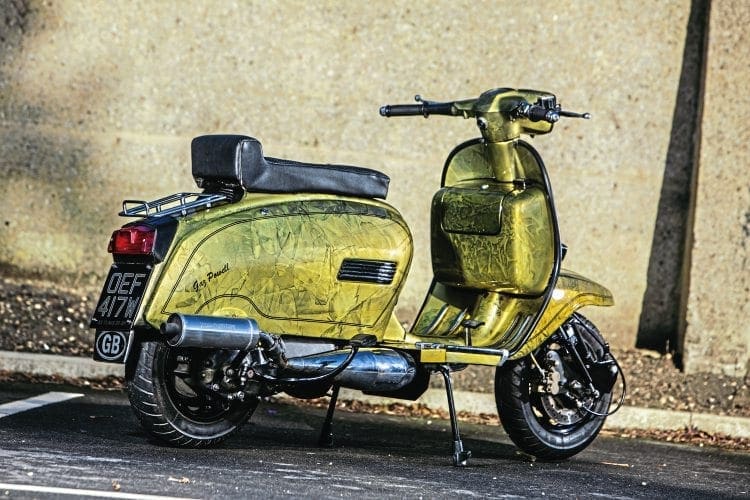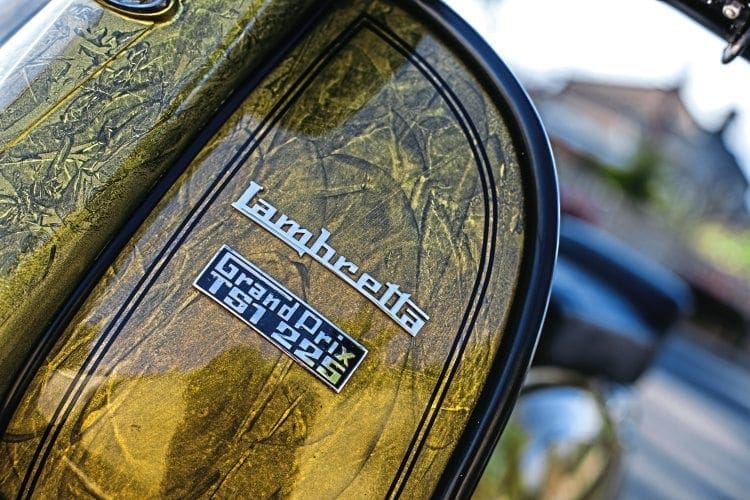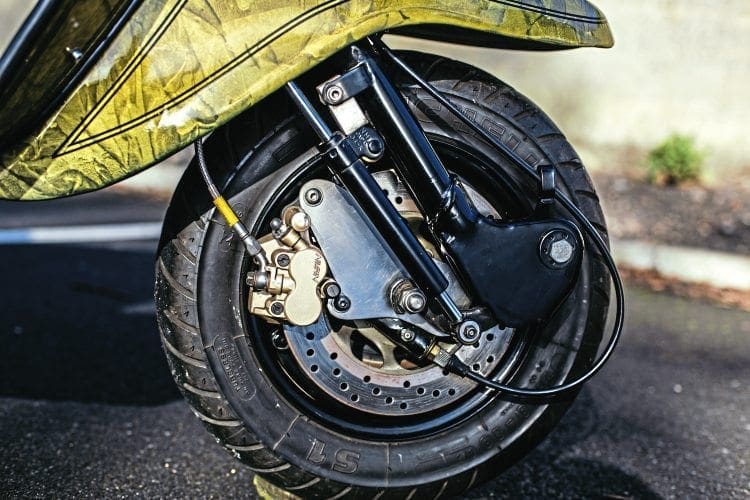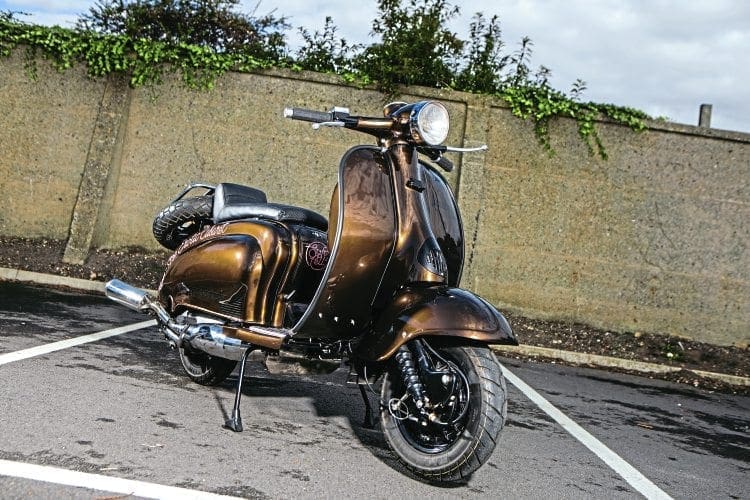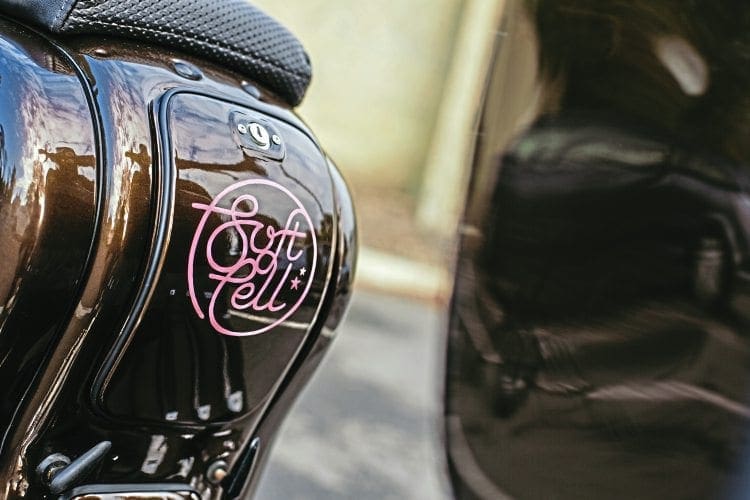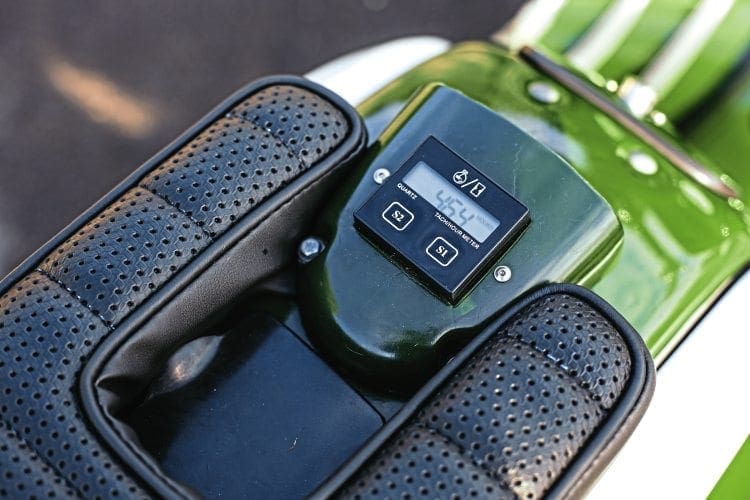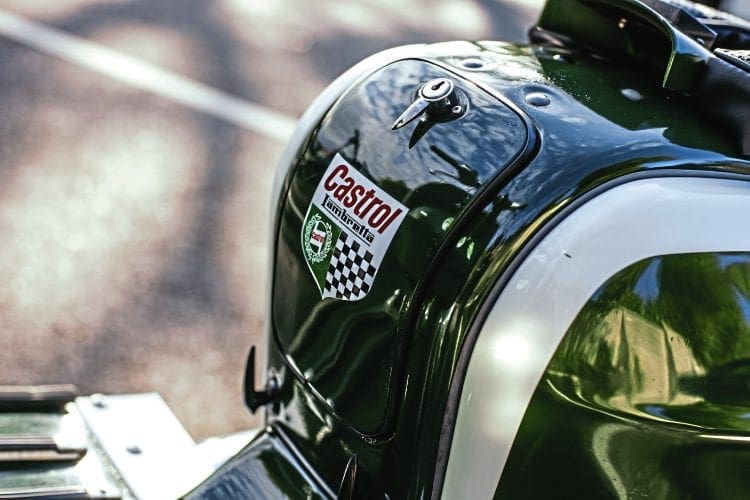It’s an accepted fact that building scooters, particularly Lambrettas, is an expensive business. Gary Powell, however, disagrees. So follow his three-point plan to enjoy cheaper scootering…
Most of us have a list of ‘must own’ machines and at first glance, it seems that Gary’s ticked off several of these with his GP Electronic, Series 2 Li and an SX200 — but all is not quite what it seems. Best known for his Stone Roses custom GP, Gary’s certainly no stranger to expensive projects. “If you want to enter concours events then you need deep pockets,” he says, “but something classy to ride can he built for less money than you’d imagine.”
Step One: Free your mind
It’s over 40 years since an Italian Lambretta rolled off the assembly line and around 20 years since production ended in India. There are very few ‘thoroughbred’ machines still in existence, particularly ones in regular use, yet the Indian v Italian v Spanish discussion continues to roll on. If you can escape from this debate and suddenly a world of opportunity opens up. Gary’s main advice is that there’s nothing wrong with genuine SIL (Scooters India Limited) parts but in order to avoid cheap copies they should always be sourced from a reputable dealer: “All my builds use Indian components including casings, gearboxes, crank and flywheels. I’ve used Scooter Restorations for years as their prices and quality are hard to beat.”

The same applies to frames. “There’s an obsession with Italian frames but there are still good examples from Spain and India available at reasonable prices,” said Gary. His common sense approach is difficult to argue with as long as there’s no intent to deceive. Just remember that when offered a cheap frame that the cost of small items can quickly mount up. Unless you’ve got a stock of spares in the garage buying a complete scooter, however rough, is often cheaper in the long run. As the saying goes, ‘You pay your money and take your chance.’
Step Two: Fleet management
According to Gary, the second key to success is finding a formula that works and sticking with it. “All the engines I build are basically the same. I could get more power out of them but that stresses components. By keeping revs low it reduces wear and increases reliability as they’re built to ride not race.” With slight variations, Gary’s recipe for engine happiness is a TS1 225 kit turning on a SIL crankshaft with a RB rod kit. Fuel is fed via a 34mm Dellorto VHSB carb mounted on a MB manifold and gases are expelled via Saigon Scooter Centre’s version of the old Taffspeed expansion chamber. Once casings are matched to the barrel all the top end components are fitted straight out of the box.
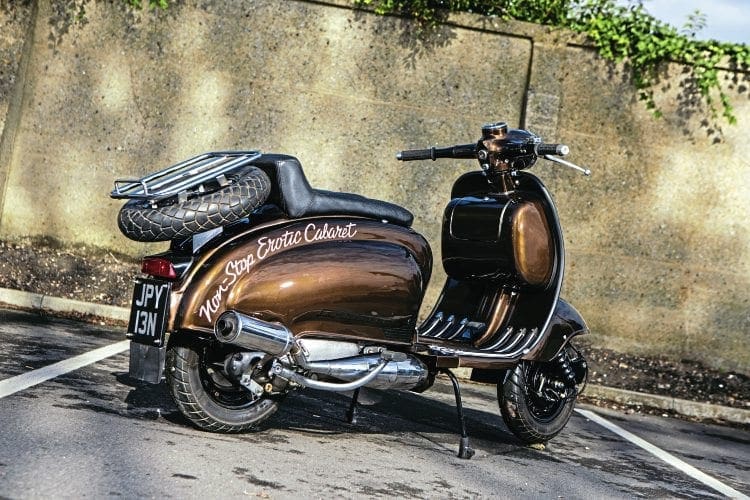
Sparks are provided by a SIL electronic ignition. However, Gary rebuilds the stator, welds the boss and lightens the flywheel. A SIL GP200 gearbox with 19/46 sprockets mated to a four-plate Surflex B clutch fitted with MB springs completes the package.
Gary explains this standardisation has several benefits, not least of which is ease of maintenance: “I ride all my machines so if one has a problem I know that the others won’t be far behind.” A recent example of this was a worn carburettor slide. “Vibration had caused damage to the slide on my GP. While looking for a replacement I found that one supplier had them on offer. I know how many engines I’ve got out there so bought one for each. Savings like that mount up.”
Of course not everyone runs a fleet of scooters but the same principle would apply to club mates.
Step Three: Maintenance
Finally, Gary’s keen on routine maintenance. “I strip the engine down after its first 1000 miles and conduct a visual examination. Piston rings and reed valves are checked every 5000 miles.” Admittedly not everyone’s a competent mechanic but investing in a decent workshop manual, some basic tools and having a go, even if it’s just tackling simple tasks at first, can save a lot of hard earned cash. An often overlooked part of maintenance is keeping things tidy. Making sure everything is clean and straight isn’t just about appearances — giving your scooter a regular examination means any problems become obvious before they can cause more serious damage.
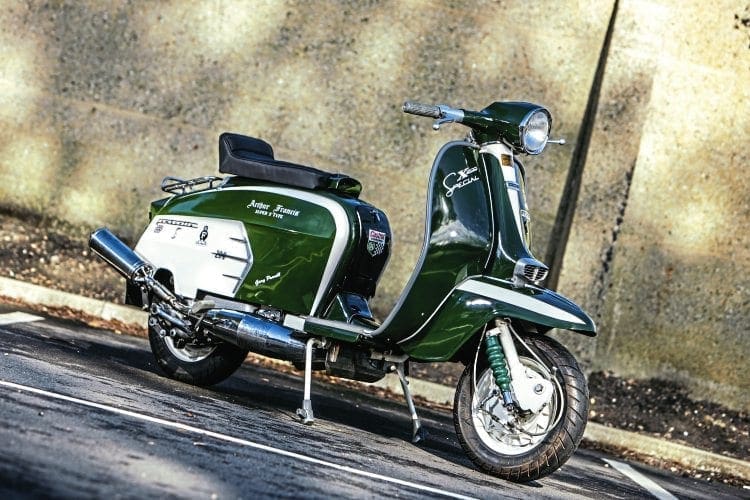
Still not convinced?
Purists may take issue with Gary’s approach but as classic scooters continue to rise in price few can argue that it makes sense both financially and for sheer riding pleasure. Gary’s not one for keeping receipts but a quick calculation reveals that he’s built all three of these beautiful (and reliable) machines for less than the price of a restored SX200.
As the Americans would say: “You do the math.”
OWNER DETAILS
Name: Gary Powell
Job: Senior project manager for an Asset Management Company.
Scooter club & town: The exclusive Hartlepool Lambretta Club, Hartlepool.
How and when did you first become interested in scooters: I was a Mod at school and always wanted one for as long as I can remember. Lad over the road who was a few years older than me got one and I used to have my nose pressed again the window whenever I heard it.
What was your first scooter: Box standard 50 Special at 15 to get it ready for my 16th and be road legal – it was quickly converted to a whopping 110 with a bigger carb and expansion pipe!
Favourite scooter model: SX or GP but as long as Vespa or Lambretta I like them all – with the exception of the GTS!
What is your favourite style of custom scooter: I can appreciate anything that’s done well.
First rally or event: Redcar Frontline SC.
How did you get there: On the 50 Special flanked by a mate on a metal flake AF painted GP.
Favourite and worst rally/event: I’m not a lover of holiday park rallies, but I can’t say I have been on a bad rally – I always seem to manage to have a good laugh and a few beers so I can’t ask for much more.
Funniest experience with a scooter: Christ there’s been plenty – not funny at the time but it sticks in my mind – I remember coming home from an LCGB rally at Kettering and I wasn’t feeling very well, must have been a bad pint, anyway got on the M1 and thought right, come on, head down… bike seemed to be struggling in fourth, dropped into third back into fourth, then a coach went past me and everyone was pointing – when I looked back me tent had come out and was acting like a parachute behind me!
Furthest ridden on a scooter: One of the NSRA Euro Rallies.
What do you like about rallies/events: Just meeting up with mates from around the country, having a beer or two and a laugh. I’m still enjoying Nationals because of the mates I have but leaning more and more to LCGB events.
What do you dislike about rallies/events: I try not to be negative about it, as rallies/scootering mean different things to different people but it’s probably these people who feel the need to dress up for a rally in what they perceive as the correct attire… I leave it at that.
Favourite Scootering feature: Technical.
Favourite custom/featured scooter of all time: Difficult one but I think it would have to be a Howlett creation or the Rosa Bianca DTC. There was a purple Rolling Stones themed bike called Aftermath that I always liked.
Recommended scooter part or item: If it’s riding gear get a good protective stuff and wear it!
What’s the most useless part you’ve ever bought for one of your scooters: A Leovinci exhaust for a P2 that reduced the top end and virtually wiped out fourth gear at the sight of an incline or the lightest of breeze!
GP ELECTRONIC
Probably the most conventional of Gary’s scooters is the GP. One of a number of machines imported from India in a sorry state a decade or so ago it was purchased as a bare frame with panel-work and a SIL 200cc engine from Scooter Restorations for £550. As Gary reminds us, “They were cheap back then!”
The most distinctive part of this machine is its paint job which, in accordance with Gary’s principles was done on a budget: “It was applied by my mate in town, It’s a black base with silver paste and a transparent coat. He did all the painting and I applied the cling film that gives the marble effect when draped over soft paint. I bought the materials which were around £100 and it was done as a favour for doing some scooter work for him. Neither of us had any previous experience with the cling film technique but thought we’d give it a go. People get hung up on paint but the worst that can happen is rubbing it down again. We started at 8am and he was at the football that afternoon! I added the pinstriping later as it looked a bit hare.”
GP SCOOTER DETAILS
Scooter model: SIL GP – Came from Scooter Restorations as a bare frame, panelwork and a genuine SIL factory engine (£550).
Date purchased & cost: Couple of hundred quid – came from Scooter Restorations as a bare frame, panelwork ad a genuine SIL factory engine (£550). They were cheap back then!
Inspiration for project: After building the SX I wanted a tidy GP for hard rally work.
Engine spec: TS1225.
Crank: SIL Webs with RB rod kit.
Carb: 34mm VHSB on MB manifold and standard reed block.
Exhaust: SSC Taffy in stainless steel.
Clutch: Four-plate Surflex B with MB springs.
Gearbox: SIL GP200 with 19/46 sprockets.
Porting work by: I matched the casings to barrel and that’s it. Built by me.
Other: Genuine SIL flywheel and stator – stator rebuilt, flywheel lightened and boss welded (to what is now classed as mid-weight). Twin-tank conversion.
Paintwork & murals done by: My mate in town, he did all the painting and I did the cling-film work. I bought the paint which cost somewhere in the order of 100 quid. The pinstriping came later after I’d had time to digest the look and decided it needed something extra.
Is there any powder coating: Everything that’s not painted including the frame (loop wet painted) by a local company.
Overall cost: About £2500-ish but I never keep a count.
Do you have any advice or tech tips for anyone starting a project: Just do it, but dry fit everything and don’t expect new parts to fit or work no matter how so-called top end they are.
Is there anyone you wish to thank: DSC Scotty for some help on the way.
SERIES 2 LI
Only the registration plate gives away the secret of this Series 2. It’s based on the humble API Lamby. Almost identical to its ancestors, Indian Lamby frames can still be obtained at bargain basement prices. This example was purchased two years ago for £200 and now sports fibreglass panels.
Breaking with his convention the Lamby uses a 150cc block modified by Oiltek to fit a TS1 200 kit. This was sleeved to 66mm to take a Yamaha LT175 piston and modified head by Ron Phillips at Fahron Engineering. As Gary explains: “It’s incredibly smooth and civilised when in town but still pulls well on the open road. It doesn’t have the 225/big carb punch but I wasn’t looking for that with this.”
The main paint job cost £300 and was applied by a local sprayer. The sign-writing was applied by an old skool sign-writer. “He remembered doing my 50 special back in 1988/89 and was over the moon to be doing some traditional work again.” Gary laughs when asked about the Soft Cell tributes: “I thought there were enough Paul Weller themed scooters out there.”
S2 SCOOTER DETAILS
Scooter model: API Lamby 150 frame
Date purchased & cost: I bought it as a bare frame a couple of years ago for less than 200 quid.
Inspiration for project: Just wanted a tidy S2 and thought let’s go Indian!
Time to build & by who: It as built by me from a bare frame.
Engine spec: TS1225 sleeved to 66mm and tweaked, with a Yamaha IY175 piston, modified head by Ron Phillips at Fahron Engineering.
Crank: SIL Webs RD400 rod.
Carb: 30mm PHBH on MB manifold and standard reed block.
Exhaust: SSC Taffy in stainless steel.
Clutch: Four-plate Surflex B with MB springs.
Gearbox: SIL GP200 with 19/46 sprockets.
Porting work by: Casing was a SIL 150 converted by OilTek and I matched the casings to barrel and that’s it. Built by me.
Other: Genuine SIL flywheel and stator – stator rebuilt, flywheel lightened and boss welded (to what is now classed as mid-weight). Twin tank conversion.
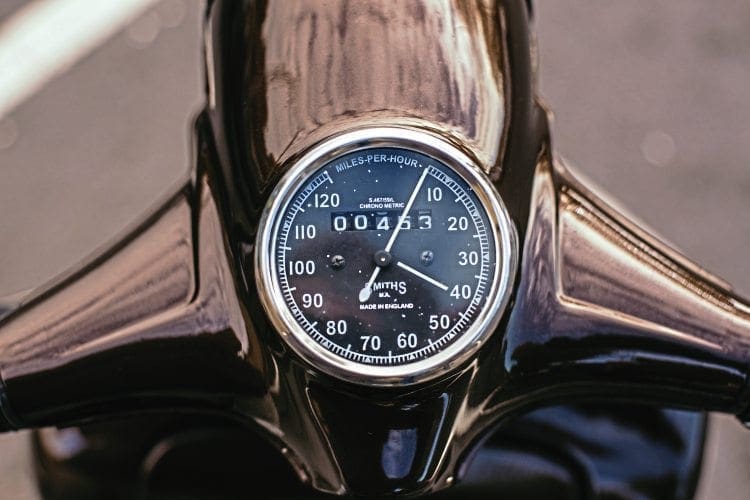
Top speed & cruising speed: TS1 200 with smaller carb so 70 and 60 – it rides incredibly smooth and civilised when in town but can still pull well on the open road.
Paintwork & murals done by: A mate in town for £300! The paint is BMW Marrakesh pearlescent brown. No murals but sign-writing is hand done by an old boy in town who did my 50 Special and first PX back in ‘88/89. He remembered me and was over the moon to be doing some traditional hand work on a scooter.
Is there any powder coating: Everything that’s not painted including the frame (loop wet painted) by Elite Coatings in Darlington.
Overall cost: About £2500-ish but I never keep a count.
Is there anything still to add to the scoot: A mural of Mark and Dave (Soft Cell) in their heyday on the toolbox door.
Is there anyone you want to thank: DSC Scotty for some help on the way.
ARTHUR FRANCIS SX200
To demonstrate that Gary’s not fixated on Indian machinery and finally prove that it’s possible to build a stunning machine on a budget is this Spanish Jet 200. “After completing the Stone Roses custom I wanted something for hard rally use,” he said. “I was offered this as an incomplete non-runner for a reasonable price and it took around a year to build.” The paint was applied locally to what are mostly Spanish panels and Gary’s particularly proud of the sign-writing: “It’s all my own work, but in fairness, stickers aren’t that difficult!”
The ‘Jet X’ has been Gary’s regular rally going machine since 2001 and has been remarkably trouble free. The only major work required being a repainted side panel after it sprang free. In a display of consistency Gary now needs to make this repair on the Lamby whose side panel fell off on the way home from our photoshoot!
SX SCOOTER DETAILS
Scooter model: Jet 200
Date purchased & cost: Couple of hundred quid as a non-runner and parts missing.
Inspiration for project: After building the Stone Roses custom I wanted a tidy SX for rallying.
Time to build & by who: It was built by me – took about a year. It’s been on the road since 2001.
Engine spec: Box standard TS1225.
Crank: SIL Webs with RB rod kit.
Carb: 34mm VHSB on MB manifold and standard reed block.
Exhaust: SSC Taffy in stainless steel.
Clutch: Four-plate Surflex B with MB springs.
Gearbox: SIL GP200 with 19/46 sprockets.
Porting work by: I matched the casings to barrel and that’s it. Built by me.
Other: Genuine SIL flywheel and stator – stator rebuilt, flywheel lightened and boss welded (to what is now mid-weight). Twin tank conversion.
Paintwork & murals done by: My mate in town, few hundred quid – I added all the AF and logos etc. – all stickers! Been on the road since 2001. Had to get one panel redone after it fell off!
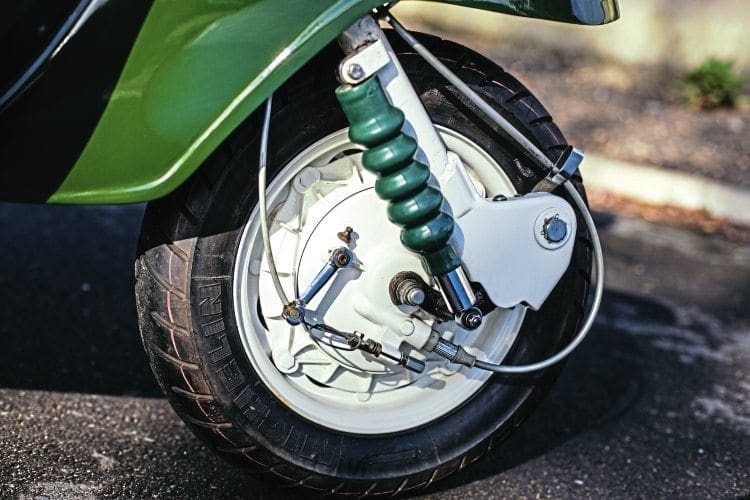
Is there any powder coating: Everything that’s not painted.
Overall cost: About £2500-ish but I never keep a count.
Do you have any advice or tech tips for anyone starting a project: Like I said, dry fit everything and don’t expect new panels to fit – there’s just no guarantee.
Is there anything still to add to the scoot: Nothing to add – just keep it on the road!
In hindsight, is there anything you would have done differently: No, I think it came out well, all things considered.
Is there anyone you wish to thank: Not really.
Words: Stan
Photographs: Gary Chapman


